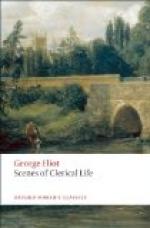Most people must have agreed with Mrs. Raynor that the Confirmation that day was a pretty sight, at least when those slight girlish forms and fair young faces moved in a white rivulet along the aisles, and flowed into kneeling semicircles under the light of the great chancel window, softened by patches of dark old painted glass; and one would think that to look on while a pair of venerable hands pressed such young heads, and a venerable face looked upward for a blessing on them, would be very likely to make the heart swell gently, and to moisten the eyes. Yet I remember the eyes seemed very dry in Milby Church that day, notwithstanding that the Bishop was an old man, and probably venerable (for though he was not an eminent Grecian, he was the brother of a Whig lord); and I think the eyes must have remained dry, because he had small delicate womanish hands adorned with ruffles, and, instead of laying them on the girls’ heads, just let them hover over each in quick succession, as if it were not etiquette to touch them, and as if the laying on of hands were like the theatrical embrace—part of the play, and not to be really believed in. To be sure there were a great many heads, and the Bishop’s time was limited. Moreover, a wig can, under no circumstances, be affecting, except in rare cases of illusion; and copious lawn-sleeves cannot be expected to go directly to any heart except a washerwoman’s.
I know, Ned Phipps, who knelt against me, and I am sure made me behave much worse than I should have done without him, whispered that he thought the Bishop was a ‘guy’, and I certainly remember thinking that Mr. Prendergast looked much more dignified with his plain white surplice and black hair. He was a tall commanding man, and read the Liturgy in a strikingly sonorous and uniform voice, which I tried to imitate the next Sunday at home, until my little sister began to cry, and said I was ‘yoaring at her’.
Mr. Tryan sat in a pew near the pulpit with several other clergymen. He looked pale, and rubbed his hand over his face and pushed back his hair oftener than usual. Standing in the aisle close to him, and repeating the responses with edifying loudness, was Mr. Budd, churchwarden and delegate, with a white staff in his hand and a backward bend of his small head and person, such as, I suppose, he considered suitable to a friend of sound religion. Conspicuous in the gallery, too, was the tall figure of Mr. Dempster, whose professional avocations rarely allowed him to occupy his place at church.
‘There’s Dempster,’ said Mrs. Linnet to her daughter Mary, ’looking more respectable than usual, I declare. He’s got a fine speech by heart to make to the Bishop, I’ll answer for it. But he’ll be pretty well sprinkled with snuff before service is over, and the Bishop won’t be able to listen to him for sneezing, that’s one comfort.’
At length the last stage in the long ceremony was over, the large assembly streamed warm and weary into the open afternoon sunshine, and the Bishop retired to the Parsonage, where, after honouring Mrs. Crewe’s collation, he was to give audience to the delegates and Mr. Tryan on the great question of the evening lecture.




